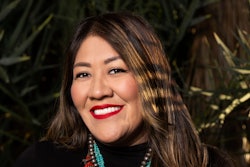Nearly 54% of working age adults in the U.S. have achieved some kind of postsecondary degree or credential, putting the country even closer to the Lumina Foundation’s goal of 60% attainment by 2025.
Lumina, a private nonprofit working to increase learning opportunities for all after high school, has been tracking credential and degree attainment for adults from 25 to 64 years of age since 2008. The latest numbers for 2021 have revealed the largest two-year increase in degree attainment since Lumina began this project.
 Dr. Courtney Brown, vice president of impact and planning at Lumina Foundation.
Dr. Courtney Brown, vice president of impact and planning at Lumina Foundation.
To create its Stronger Nation report, Lumina uses data collected by the American Community Survey, part of the U.S. Census, to track associate, bachelor’s, and graduate or professional degree attainment, as well as the Georgetown University Center on Education and the Workforce to track certificate and certification attainment. Data is broken down by state and by race and ethnicity, with the highest attainment found in D.C. at 72.4%, and the lowest attainment in Nevada at 43.9%.
“Even during the pandemic and economic crisis we’ve experienced, [the attainment rate] has grown every year, thanks to hard work across the nation, communities, and states, through strong partnership and better measurement,” said Brown.
While Brown acknowledged the latest numbers as a mark of success, it remains marred by the continued, stubborn gap in achievement between white and Asian American Pacific Islander (AAPI) populations and Black, Latinx, and Native American populations. While all racial groups saw an increase in attainment, Black, Latinx, and Native American attainment remain 15 percentage points or more below the national average.
“Seeing gaps in opportunities for continued progress helps us to sharply focus efforts as we move forward as a nation, as states, and in our communities,” said Brown. “It reinforces the urgent need to speed up progress, especially knowing tomorrow’s students will be even more diverse.”





















